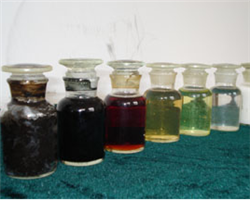 People continuously deepen their understanding about the mechanism of the acid-rock reaction during acidizing. Especially in the late 1990s, the U.S. oil services company Halliburton and others largely understood the chemical behavior of the reaction between HF and rock during acidification of silicate formation by NMR, induction coupling, scanning electron microscopy, X-ray diffraction and other advanced techniques. A third order reaction kinetics was proposed for HF and aluminosilicate and it was pointed out that severe formation damage is caused by traditional HCl and mud acid. The organic acid system has the unique characteristic of reducing the formation damage from acid solution. Therefore in 1990s studies and applications of non-hydrochloric acid caught the great attention of acidification researchers. Among them the focus is on the application of organic acid system.
People continuously deepen their understanding about the mechanism of the acid-rock reaction during acidizing. Especially in the late 1990s, the U.S. oil services company Halliburton and others largely understood the chemical behavior of the reaction between HF and rock during acidification of silicate formation by NMR, induction coupling, scanning electron microscopy, X-ray diffraction and other advanced techniques. A third order reaction kinetics was proposed for HF and aluminosilicate and it was pointed out that severe formation damage is caused by traditional HCl and mud acid. The organic acid system has the unique characteristic of reducing the formation damage from acid solution. Therefore in 1990s studies and applications of non-hydrochloric acid caught the great attention of acidification researchers. Among them the focus is on the application of organic acid system.
We developed two types of non-hydrochloric acid/mud acid systems based on foreign patents and the study of our sister companies. Good result is obtained in field trial.
1. Comparison between organic acid system and mud acid system
(1)The organic acid system has low corrosion with corrosion rate at 3g/m2·h at 90℃, and that of hydrochloric acid/mud acid system is 5~10g/m2·h.
(2)The organic acid system is weak acid and is favorable for the protection of formation since the formation is not sensitive to weak acid. On the other hand, HCl is a strong acid and the formation is very sensitive to it.
(3)Dissociation of H+ is relatively slow from organic acid. It is not easy to produce acid sludge by reacting with crude oil. But dissociation of H+ from hydrochloric acid/mud acid is relatively fast. Because of the concentrated charge it is easy to react with crude oil and form acid sludge, causing permanent damage to formation.
(4)The organic acids have a slower reaction with formation components, difficult to generate large amount of migrating particles to block the formation. It is also not easy to generate excess particles to stabilize the oil/acid emulsion. On the other hand, in hydrochloric acid and mud acid system the reaction is fast, causing particle migration and secondary damage.
2. Organic acid system
(1)composition:
Composed of organic acid/hydrofluoric acid with different additives.
(2)Typical physical properties /Technical data:
① Appearance: Brown red transparent liquid;
② Density:1.05~1.10g/cm3;
③ Dispersivity: soluble in water at any ratio.
④ The inhibition rate for calcium carbonate is 5-12 times. (The time consumed for 15% HCl decreasing to 1.5% is used as standard for comparison).
⑤ Corrosion rate:less than 4g/m2·h at 90℃ at atmospheric pressure for 4h (The concentration of corrosion inhibitor is only half of that in hydrochloric acid/mud acid system)
⑥Resistance to sludge:no acid sludge produced.
⑦Surface tension:≤3dy/m。
(3)Use:
①pre- treatment liquid: 1:4 dilution 2.5m3/m
②Treatment liquid: 1:4 dilution 2.5m3/m
③After-treatment liquid: the same as a typical acidification.
3. Organic Retarding Acid System
(1)Components:
Composed of organic acid with multiple H+ ions and a few inorganic salts, this system began to react to form acid continuously at 60℃ with the consumption of H+. Different additives are added in the system.
(2)Typical physical properties /Technical data:
①Appearance: Brown red transparent liquid;
②Density:1.03~1.08g/cm3;
③Dispersivity: soluble in water at any rate, transparent.
④The inhibition rate for calcium carbonate is 2-5 times (under the same condition as the organic acid system).
⑤The buffer capability for SiO2 is 3-6 times (Assume the hourly dissolution quantity of SO2 is 1 for 3% HF solution).
⑥Surface tension:≤3dy/m。
⑦Demulsification capability: Water discharge≥95%
⑧Corrosion rate: less than 4g/m2·h at 90℃ under atmospheric pressure for 4h.
(3)Uses:
①Pre-treatment solution: 1:3 dilution 2.5m3/m
②Treatment solution 1:3 dilution 2.5m3/m
③After-treatment solution: the same as a typical acidizing.